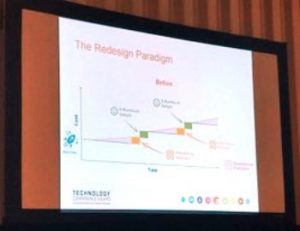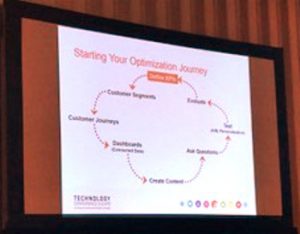Where Did the Milk Go?!
Or, Why You Should Optimize Your Website Before Redesigning It


Picture your favorite grocery store. You walk in and realize that everything in it has been reorganized. Your quick errand has now become an aimless wander through the store, searching for those few items that are no longer where you left them. Frustrating, right?
Now picture this same feeling entering a once-familiar website. Association members encounter this same issue when their association redesigns their website. While a new website design may be a refreshing, needed change, the process means that well-used resources, links or downloadable forms are relocated or renamed, leaving frequent site visitors frustrated and unsure where to go to find the information they regularly need.
Sometimes a website redesign is necessary to keep up with changing trends in online design, to reflect new branding or to update the functionality in order to take advantage of new online capabilities that are geared toward more streamlined convenience. A website redesign in itself is not a bad idea. However, before embarking on a redesign, your association should thoroughly consider two ideas central to the purpose and benefit of your website:
- How members currently use your website? Can a redesign improve their user experience?
- How do current website ad opportunities benefit your association? Can you improve advertiser ROI through an updated design?
How do members currently use your site?
If you don’t readily know the answer, take the opportunity to ask for their input. A survey about your website doesn’t have to be complicated – it can be as simple as setting up a few questions through an online survey tool and soliciting responses or coming up with a short list of questions about how and why members use your website and having your staff ask members in person at your next events. You will need to invest time and effort into creating the survey/coming up with a standard set of questions, but the dividends this concerted inquiry will pay in the form of member satisfaction is invaluable.
Some sample questions to ask:
- What do members like about your site’s design?
- What do they not like about the design?
- Which resources, forms, links and information hosted on your site do they use most frequently?
- Which resources do they not use?
- What capabilities do members wish your website had?
- What device do they most often use to visit your website?
Once you have several responses to these types of questions, you’ll likely see a pattern emerge regarding what members enjoy about your association’s website and what they think could be improved upon.
Your website traffic metrics are also a valuable data source to understand how visitors are using your site and which areas need improvement. Numbers don’t lie, and the traffic statistics you can see through a comprehensive website profile (provided by almost every site host, or through Google Analytics) will give you a wealth of information if you know how to decipher the stats.
 At ASAE’s 2016 Tech Conference, Kristen Garman of the National Association for College Admission Counseling and Frank Klassen and James Stout of Brightfind recommended reviewing these critical and important website settings:
At ASAE’s 2016 Tech Conference, Kristen Garman of the National Association for College Admission Counseling and Frank Klassen and James Stout of Brightfind recommended reviewing these critical and important website settings:
- Domain and URL canonicalization
- Removal of all internal traffic which includes association staff and vendors that often access your site
- Subdomain tracking settings
- Internal search capabilities (how easy is it for people to search for what they need within your website?)
Other metrics your staff should examine include:
- Landing pages – How do people enter your site? This metric is a good measure of what is the most popular, useful information on your site. People bookmark Web pages containing information they need often.
- Exit pages – From which pages do people leave? If a certain page or group of pages have a high exit rate, it may be because information is not showing up correctly or is outdated.
- Most-viewed pages – What sections of your website do people view the most? These should be the sections people can click to from your home page. Add them to your main navigation if they’re not already there.
- Most-used forms/resources/downloads – What do people take away from your website the most? Again, make these resources easily accessible from the home page of your website if you don’t already. When online, people want information fast and with as little work (translation: clicks) as possible.
- Time spent on website – The amount of time people spend on any given website depends on how much information it contains, how integral the information is to users’ daily lives and how often it’s updated. But in general, if your website users are spending less than a minute on your site, there is probably a way for you to update posted information, fix broken images or links or add text/images you’ve been meaning to add that will keep users engaged longer and make your association website a more valuable resource without needing to redesign.
- Search data – What terms or concepts are people searching for the most within your website? Is it something that is otherwise hard to find? Is it even available through your site?
Is redesign the right answer?
Now that you have member feedback and site analytics, ask yourself: can we easily improve on any of the user complaints without a redesign? A change of colors, fonts or text sizes are superficial changes that can enhance the user experience without the need for a major overhaul. Are any links broken? Are photos or graphics not loading properly? Fix these issues before considering a redesign. You might find that usage and satisfaction with your website increases with just a few small tweaks.

What are people searching for on your website? This is the one place where your visitors are telling you EXACTLY what they want! If it’s something you think is pretty visible, your members might disagree. Are people searching for something not included in your website content, expecting it to be available? Consider adding that extra content.
Are there online capabilities members are asking for that can be added to our existing website structure? For example, it’s easy to add commenting capabilities or polls through widgets in order to add more interactivity to your website and open up additional feedback loops (thus further encouraging association-to-member communication).
Are there sections of your site that you believe should be highly trafficked, but aren’t? Changing the way to access those pages or adding more quick links to those pages can help by making the information more visible.
Your staff should simultaneously be comparing your site’s usage with your website goals. Garman, Klassen and Stout recommend defining goals and then identifying a few key performance indicators (KPIs) specific to each goal. KPIs can be anything: number of successful membership applications online, number of pages viewed prior to joining or renewing membership or number of clicks after a site search, but they won’t be the same for every goal you set. Setting up custom dashboards in Google Analytics to give you visibility of your KPIs per goal will immediately indicate what is not working on your website and needs improvement.
If redesigning your website is necessary to meet the needs of your members and site visitors, timing of that design is important to ensure you keep disruptions to visitors and advertisers at a minimum. Website redesigns can become an expensive and lengthy process that also take up a lot of staff time. You should plan around events and other association responsibilities that already occupy a majority of your staff’s time during certain parts of the year. This will keep your from staff being overwhelmed and/or the website redesign stalling.
Optimizing the website your association already has can go a long way toward improving the member experience without the time and monetary expense of a whole redesign, while also maintaining the benefit of member familiarity. Consider these user experience factors and your association’s goals before making a decision whether or not to redesign.
How would a website redesign affect your ad revenue?
A factor that is often forgotten but can be very important to your association is website advertising revenue. Whether you already earn solid website revenue or you don’t but would like to start earning upon redesign, advertising is an integral part of any website redesign process. Changing website design often means changing the size/type/position of ad spaces because of changing text spaces, menu placement and overall layout. Advertisers may be pleased with the ROI they’re getting from current ad spaces on your website and may decide to cease advertising with your association if those spaces disappear without a comparable, new alternative. Making these changes may result in decreased interest in your ad spaces and decreased revenue, especially if new ad space opportunities don’t deliver the same ROI as old ones. Include your advertising sales team in the conversation to help your Web team understand how changes to website design will impact ad revenue.
Consider your current website advertising commitments as well. A redesign will require some transition for them, but launching a redesigned association website at a time when most contracts are ending and advertisers are planning their next ad campaigns can help to make offering new ad spaces a smooth transition.
Optimize Before Redesigning
 An association website redesign is sometimes necessary. With changing technology and trends in desired online conveniences, redesigning your website can give you an opportunity to showcase those favorite resources in a better way and make them more easily accessible to the people who use them most.
An association website redesign is sometimes necessary. With changing technology and trends in desired online conveniences, redesigning your website can give you an opportunity to showcase those favorite resources in a better way and make them more easily accessible to the people who use them most.
However, optimizing your current website is often a better use of your time and funds. Examine your metrics, encourage member feedback, and once you find what does or does not work well, you can know what to improve upon. Make popular resources more accessible with a simple reorganization of menus and links. Fix all broken download links and images. Website visitors are your guests – clean up for them! Next, examine your advertising situation: if your association cannot prove an obvious increased ROI for your advertisers resulting from a new site design, your advertisers and your revenue column are better off making slight tweaks to existing ad spaces and saving a complete redesign for when it makes more financial sense.
If you ran your favorite grocery store, this might equate to finding out that frequent shoppers like knowing where staples like bread, milk and medicines are located, and either keeping those items in their same location or placing them even closer to the checkouts than before (and letting everyone know about this convenient move). This would allow shoppers to zip in and out for high-volume items quickly, providing an overall pleasant customer experience and encouraging repeat visits.
Treat your website the way you want your grocer to treat your favorite grocery store. Make it easy to find needed items quickly, keep the appearance clean and unfettered and respond to your customers (members) with care. When your website is optimized for easy, enjoyable use, they’ll keep coming back!

